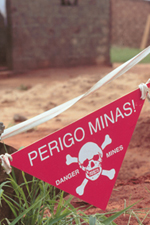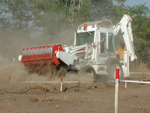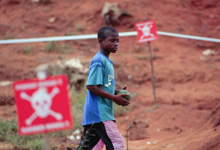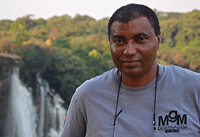Research

Humanitarian and non-Commercial Research
MgM also strongly engages itself in research. Even in this area MgM maintains a charitable and non-commercial approach.
From the beginning MgM publicized the development of some new machines for mine clearing or for the support of manual clearing. MgM prompts all mine clearing organizations to copy these methods free of charge. Thus MgM deliberately does not restrict this request by copy rights or patents in order to allow a worldwide distribution of these methods. The non-profit innovation of mine clearing technique is one of the primary principles of the German charitable association.
MgM-machines are presently operating in Afghanistan and Iraq for example, in Honduras and of course at the MgM operations in Angola.
Here are some examples for MgM-research, which contribute to making the world a safer place.

The MgM-Rotar MK II at work in Mozambique. A multi-tool with vegetation cutter at the rear.
Rotar MK2
The Rotar MkII is a multi-tool workhorse, which includes the functions of a Rotar, Mulcher, Crane, Dozer, Scraper, Loader, Excavator, Tipper etc.
Its benefits of versatility, safety, low investment and sustainability through reduced operating costs outweigh the slightly better performance of a combination of a few, expensive, single purpose machines.
Based on the very successful experience with MgM Rotar MK-I, a further version was developed and named MK-II. It is based on a lighter carrier vehicle and including additional demining tools. Rotar MK-I was built on a fully armoured Caterpillar 916 front-end loader specifically designed for maximum threat scenarios including anti-tank mine blasts. For scenarios with a minor threat level such as are frequently found in Mozambique, Laos, Cambodia etc a lighter version would be desirable because of better maintenance/running costs.

The MgM Samil 20 Mulcher. Armoured vehicles with hydraulic vegetation cutters are very much faster - and much more safe than doing the job by hand.
MgM - Vegetation cutter
In almost all mine affected countries an independent agriculture is of crucial significance. It is the only way to prevent famines or yearlong dependence on food aid programmes in overcrowded refugee camps.
- In many regions which are agriculturally profitable it is impossible to use heavy demining machinery like track-type vehicles, because they would destroy the thin layer of humus. Therefore those regions are manually demined, at best with the help of light mobile devices.
- The first step has to be the removal of vegetation which is strenuous work. Regular detector work is impossible in an overgrown field that has not been used for years, because the deminer needs free space to swivel the detector.
- And, apart from the “regular“ mines, other dangers are lurking in the undergrowth: hidden charges which are released by thin, almost invisible wires. They make the cutting of vegetation an enormously time-consuming, hard and dangerous job. To make this process faster and safer, MgM introduced hydraulic vegetation cutters to the world of demining years ago. These are mounted to mine-protected and armored trucks. They made the vegetation cutting part of the demining process many times faster and completely safe.





